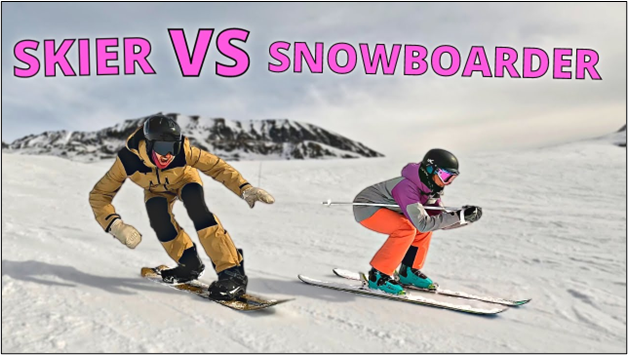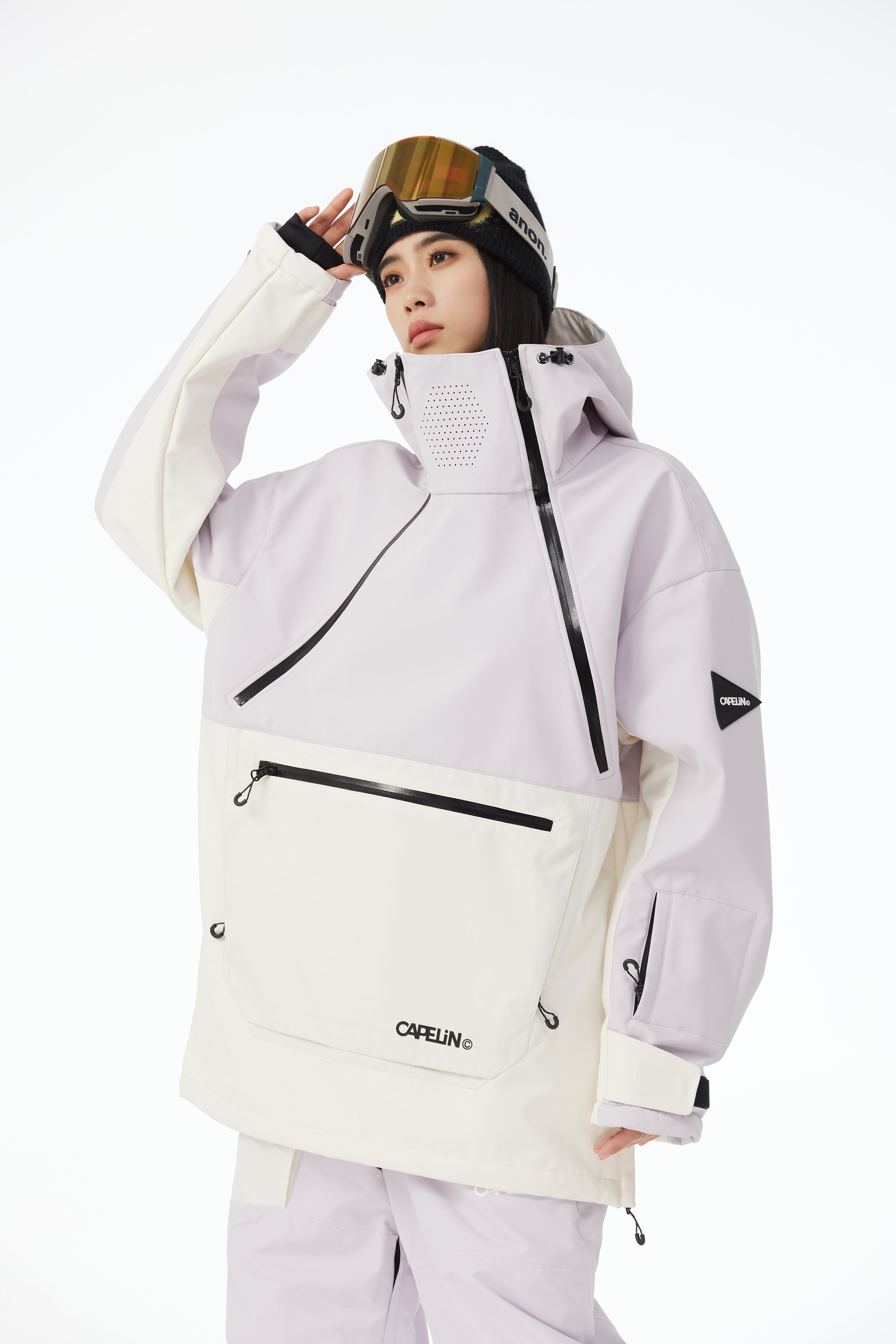スキーとスノーボードは、スピード、俊敏性、そして自然との一体感を独自に融合させた、最も爽快なウィンタースポーツの2つです。これらのアクティビティは、澄み切った高山の空気の中での逃避行を提供し、個人の挑戦と成長を促すプラットフォームとなります。
冬季スポーツ愛好家の間では、スキーは一般的に習得は簡単だが上達は難しい、一方スノーボードは習得は難しいが上達は簡単であるという意見が一致しています。
毎年何百万人もの人がスキー場に集まる中、スノーボード愛好家の間では「スノーボードはスキーより難しいのか?」という議論が続いています。早速、その答えを探ってみましょう!

学習曲線
初期学習段階
スキーもスノーボードも、そのユニークな挑戦と楽しみで初心者を魅了するスリル満点のウィンタースポーツです。
私スキーは両足を独立して動かせるため、最初は直感的に操作できると感じる人が多いでしょう。そのため、最初の数日間はスキーの方が楽に滑れるように感じるでしょう。バランス感覚と協調性は、最初から非常に重要になります。スキーでは、初心者でも2枚の板に体重を分散させることができます。正直なところ、スノーボードのように1枚の板を使うよりも、はるかに楽に滑れるかもしれません。
熟練度への進歩
上達するにつれて、それぞれのスポーツの微妙な違いがより鮮明になってきます。スキーは比較的簡単に始められると思われがちですが、真にマスターするには高度な技術が求められます。一方、スノーボードは、かかととつま先のエッジを自信を持って使いこなしてコントロールすることが基本的な課題となるため、最初の習得曲線はより急峻になる可能性があります。しかし、これらの基本を習得すれば、特に大胆で限界に挑戦する意欲のあるスノーボーダーは、より早く熟練レベルに到達できることが多いです。
初心者から中級者、そして上級者へとレベルアップしていく過程は、個人の達成感と爽快感に満ちています。スキーヤーにとっては、カービングや様々な地形へのタックルといった技術を磨く過程であり、スノーボーダーにとっては、ターンを完璧にこなし、様々な雪質をマスターする過程です。
さらに、スキーでは「習得は簡単だが、習得は難しい」という概念と、スノーボードではその逆という概念は、多くの愛好家の経験を要約したもので、スキルが向上するにつれて両方のスポーツがやりがいのあるものになることを浮き彫りにしています。
身体的要求
筋肉と心血管の要件
スキーもスノーボードもかなりの筋力と心血管系の持久力を必要としますが、ターゲットとする筋肉群とエネルギーシステムは異なります。
スキーは、斜面を滑るために大腿四頭筋、ハムストリングス、そして臀筋を継続的に使うスポーツであるため、主に脚力と持久力を必要とします。スキーは、長時間にわたる一連の力強い動きを特徴とする反復的なスポーツであるため、いわゆるパワー持久力が必要です。
一方、スノーボードでは体幹の強さがより重視されます。強い体幹は体を安定させ、山でのバランスを向上させ、全体的な姿勢を支えます。これは効果的なスノーボードには不可欠です。
スクワット、ツイストスクワット、プランクなどのエクササイズは、スポーツの回転の側面を強化し、必要な体幹の強さを鍛えるため、スノーボーダーにとって特に効果的です。
柔軟性とバランス
スキーとスノーボードの両方において、様々な可動域での動きをこなすには柔軟性が不可欠です。特に体幹、腰、足首の筋肉を最適なコンディションに保ち、柔軟性を維持するために、定期的なストレッチが推奨されます。
バランス感覚はスキーヤーやスノーボーダーにとって非常に重要なスキルです。バランス感覚は、スキーの習得とパフォーマンスの両方に影響します。バランス感覚を重視したトレーニングは、ゲレンデでの全体的なパフォーマンス向上に役立ちます。
怪我のリスク
よくある怪我
スキーとスノーボードには、それぞれのスポーツの要求や動作の違いを反映し、それぞれ特有の怪我があります。スキーブーツが固定されていることや、転倒時に横方向の力が加わることから、スキーヤーは下肢の怪我に悩まされることが多いです。
逆に、スノーボーダーはバランスを崩して手に落ちる確率が高くなるため、手首骨折などの上肢の怪我を起こしやすくなります。
死亡者および重傷者
どちらのスポーツもリスクを伴いますが、重傷や死亡事故の性質と頻度は異なります。スキーとスノーボードのどちらにおいても、ヘルメットやリストガードなどの安全装備を使用し、安全上の注意事項を遵守することで、重傷のリスクを大幅に軽減できます。
参加者はこれらのリスクを認識し、 これらの冬のスポーツを楽しむ際に自分自身を守るために必要な手順。
心理的側面
恐怖の要因
スキーやスノーボードを始める際に、初心者が直面する心理的な大きな要素として恐怖感があります。斜面を猛スピードで滑降するというのは、想像を絶するほどの恐怖であり、転倒や怪我への恐怖が習得の妨げとなることがあります。
しかし、適切な指導と段階的な進歩があれば、この恐怖は管理でき、スリリングな冒険感に変わることさえあります。
満足と報酬
スキーやスノーボードをマスターすることで得られる満足感と達成感は計り知れません。難しい斜面を巧みに滑走したり、新しい技を披露したり、あるいは単に技術を向上させたりした時の達成感は、深い満足感をもたらします。この達成感と、このスポーツがもたらす肉体的な爽快感が相まって、スキーやスノーボードの人気は今もなお続いています。
環境と社会要因
地形、積雪状況、天候の影響
地形、雪の状態、天候は、スキーやスノーボードの習得とパフォーマンスに大きな影響を与えます。地形や雪の状態によって、それぞれ異なる課題が生じ、異なるスキルが求められます。
視界や気温などの気象条件もパフォーマンスと安全性に影響を与える可能性があります。これらの環境要因を理解し、適応することは、これらのスポーツをマスターする上で非常に重要な部分です。
社会的側面
スキーやスノーボードのコミュニティの社交的な側面は、学習を大いにサポートします。これらのコミュニティは、仲間意識、励まし、そして情熱の共有といった精神を育むことが多く、初心者のモチベーションを高め、学習を支援する環境を提供します。
グループレッスンやクラブでは、経験を共有したり、他の人から学んだりする機会も得られます。
結論
スキーとスノーボードはどちらも、それぞれ独自の課題とやりがいを持っています。習得曲線、体力への要求、怪我のリスクはそれぞれ異なりますが、どちらも計り知れない満足感と達成感を与えてくれます。
スキーとスノーボードのどちらを選ぶかは、最終的には個人の好み、体力、そしてリスクを負う覚悟によって決まります。どちらを選ぶにせよ、どちらのスポーツも冬と大自然を満喫できる爽快な方法を提供してくれます。
よくある質問
Q: 初めてスノーボードをする場合は何を着たらいいですか?
答え: CapelinCrewは初心者に3層着用システムを推奨しています。詳細については、「3層着用システム「」。












